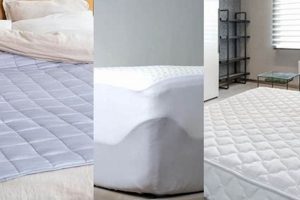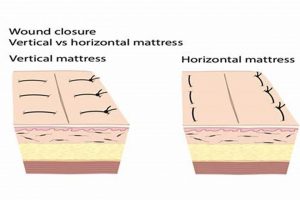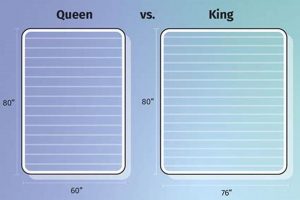The comparison of mattress heights centers around two common thicknesses. One measures twelve inches, and the other, fourteen inches. These dimensions refer to the vertical distance from the top to the bottom surface of the mattress, representing its overall profile and contributing to its feel and support characteristics. As an example, a sleeper might find a twelve-inch model sufficient for basic support, while someone requiring enhanced pressure relief could prefer the extra height of a fourteen-inch option.
Mattress thickness plays a critical role in providing optimal support, comfort, and longevity. A greater height often translates to thicker comfort layers, leading to improved pressure distribution and reduced stress on joints. This characteristic can be particularly beneficial for individuals with back pain or those seeking a more luxurious sleep experience. Furthermore, thicker mattresses may exhibit greater durability over time, resisting compression and maintaining their shape more effectively compared to thinner alternatives.
The subsequent sections will delve into a detailed examination of the factors influencing the choice between mattresses of these distinct heights. Key considerations will include the materials used in construction, the impact on support and comfort levels, and the suitability for different body types and sleep preferences. Ultimately, understanding these nuances is crucial for selecting the mattress that best aligns with individual needs and promotes restful sleep.
Guidance on Mattress Height Selection
The following insights are designed to aid in the selection process, considering the implications of differing mattress thicknesses on sleep quality and support.
Tip 1: Assess Individual Support Needs: Evaluate personal requirements for spinal alignment and pressure relief. Individuals with higher body weights or those experiencing back pain may benefit from the increased support offered by a thicker mattress.
Tip 2: Consider Sleep Position: Different sleep positions necessitate varying levels of support. Side sleepers often require thicker comfort layers to alleviate pressure on shoulders and hips, while stomach sleepers may prefer a firmer, thinner mattress to prevent excessive sinkage.
Tip 3: Evaluate Bed Frame Compatibility: Ensure the chosen mattress height is compatible with the existing bed frame. A thicker mattress may raise the sleeping surface significantly, potentially requiring adjustments to accommodate entry and exit.
Tip 4: Account for Budgetary Constraints: Generally, thicker mattresses tend to be more expensive due to the increased material usage. Factor in budgetary considerations when weighing the potential benefits of a taller mattress.
Tip 5: Research Material Composition: Investigate the materials used in the mattress construction, as the quality and density of these materials directly impact support, comfort, and durability. A thicker mattress with low-quality materials may not provide the same level of performance as a thinner mattress with high-quality components.
Tip 6: Consider Motion Isolation: If sharing a bed, evaluate the mattress’s ability to isolate motion. Thicker mattresses, particularly those with memory foam or latex layers, often exhibit superior motion isolation properties, minimizing disturbances from a partner’s movements.
These recommendations emphasize a holistic approach, acknowledging that the optimal mattress height is a function of individual circumstances and priorities.
The subsequent sections will build upon these insights, providing a comprehensive overview of mattress characteristics and their implications for sleep quality.
1. Support Layer Thickness
Support layer thickness constitutes a critical differentiator between mattress heights, directly influencing the mattress’s ability to provide adequate spinal alignment and overall comfort. The following points elucidate specific aspects of this relationship.
- Core Stability and Alignment
A thicker support core, often found in 14-inch mattresses, generally offers enhanced stability and resistance to compression. This is particularly relevant for individuals with higher body mass or those who require extra support to maintain proper spinal alignment throughout the night. Insufficient support layer thickness can lead to sagging and misalignment, potentially exacerbating back pain or discomfort.
- Material Density and Durability
Increased thickness often correlates with higher material density within the support layer. This translates to improved durability and resistance to long-term wear and tear. A denser support core maintains its structural integrity over time, preventing premature breakdown and ensuring consistent support throughout the mattress’s lifespan. In contrast, a thinner support layer may be more susceptible to compression and deformation, reducing its overall lifespan.
- Impact on Edge Support
Support layer thickness significantly contributes to the strength and stability of a mattress’s edges. A thicker support layer provides greater edge support, minimizing the feeling of rolling off the bed and maximizing the usable sleep surface. This is especially important for couples who share a bed or individuals who tend to sleep near the edge of the mattress. A thinner support layer may result in diminished edge support, leading to a less stable and less comfortable sleep experience.
- Compatibility with Adjustable Bases
The support layer’s characteristics, particularly its flexibility and density, play a role in how well the mattress conforms to adjustable bed frames. A thicker support layer, if constructed with flexible materials, can offer enhanced adaptability, ensuring that the mattress effectively molds to the contours of the adjustable base without compromising support. Conversely, a thinner or overly rigid support layer may hinder proper articulation, reducing the benefits of an adjustable bed frame.
The interaction between support layer thickness and its material composition, therefore, determines the practical benefits a sleeper derives from either a 12-inch or 14-inch mattress. The selection should be guided by individual requirements for support, durability, and compatibility with other sleep system components.
2. Overall Profile Height
Overall profile height, referring to the total vertical dimension of a mattress, directly influences accessibility, aesthetics, and the perception of support. A 12-inch mattress presents a lower profile compared to a 14-inch model, impacting the ease of getting in and out of bed, particularly for individuals with mobility limitations. For instance, an elderly person might find a lower profile mattress easier to manage. Conversely, a taller individual may prefer the increased height of a 14-inch mattress for enhanced comfort and support. The visual impact of the mattress on the bedroom’s overall design also varies with profile height; a taller mattress can contribute to a more luxurious aesthetic, while a lower profile might suit minimalist designs.
The practical significance of understanding the overall profile extends to compatibility with bed frames and bedroom furniture. A very low bed frame combined with a 14-inch mattress could result in an excessively high sleeping surface, potentially obstructing bedside tables or appearing disproportionate within the room. Conversely, a high platform bed might necessitate a thicker mattress to achieve a comfortable and visually balanced height. Furthermore, the presence of a headboard dictates consideration of the mattress profile to ensure sufficient visibility and aesthetic harmony.
Ultimately, the choice between a 12-inch and 14-inch mattress regarding overall profile height requires a comprehensive assessment of individual physical needs, aesthetic preferences, and the existing bedroom environment. Disregarding these factors can lead to a mismatch that compromises comfort, accessibility, and the overall visual appeal of the sleeping space. The interplay between height and these elements is crucial for achieving a satisfying and functional sleep environment.
3. Pressure Relief Capability
Pressure relief capability, the mattress’s ability to minimize concentrated pressure points on the body, is intrinsically linked to mattress height. A 14-inch mattress, compared to a 12-inch alternative, often provides enhanced pressure relief due to increased space for comfort layers, such as memory foam or latex. These layers conform to the sleeper’s body, distributing weight more evenly and reducing stress on areas like the shoulders, hips, and knees. Conversely, a thinner mattress may offer less cushioning, potentially leading to increased pressure point discomfort, particularly for side sleepers or individuals with pre-existing joint pain. For example, a person with arthritis might find the additional comfort layers of a thicker mattress essential for a pain-free sleep experience. The effectiveness of pressure relief is directly proportional to the depth and density of the comfort layers, a dimension often amplified by a greater overall mattress height.
The practical significance of pressure relief extends beyond immediate comfort. Prolonged pressure on specific areas can impede blood circulation, contributing to tossing and turning throughout the night and ultimately disrupting sleep quality. A mattress with adequate pressure relief capabilities can mitigate these issues, promoting more restful and restorative sleep. Consider the case of a bedridden patient; the reduced pressure on the skin minimizes the risk of developing pressure ulcers, highlighting the direct health implications of effective pressure distribution. The impact of pressure relief is also amplified by body weight; heavier individuals typically exert more pressure on the mattress surface, thereby benefiting more substantially from the increased comfort layers afforded by a taller mattress.
In summary, the relationship between mattress height and pressure relief capability is a crucial consideration for optimizing sleep comfort and minimizing potential health issues. While a 12-inch mattress may suffice for some individuals, the increased space for comfort layers in a 14-inch mattress often translates to superior pressure distribution, particularly beneficial for side sleepers, individuals with joint pain, or those with higher body weights. Understanding this connection allows for informed decision-making in mattress selection, leading to improved sleep quality and overall well-being. The challenge lies in balancing pressure relief with other factors, such as support and firmness, to achieve a holistic sleep solution.
4. Bed Frame Compatibility
The selection of a mattress height necessitates careful consideration of the existing or intended bed frame. The height of the mattress, whether 12 inches or 14 inches, directly influences the overall bed height, which subsequently affects ease of access and the aesthetic balance of the bedroom.
- Headboard Visibility
A thicker, 14-inch mattress may obscure a significant portion of the headboard, particularly with lower-profile headboards. This can diminish the headboard’s aesthetic impact and potentially render it ineffective for providing back support while sitting up in bed. Conversely, a 12-inch mattress might be more suitable for showcasing the headboard’s design. As an illustration, consider a bed frame with an ornate, low-slung headboard; a 14-inch mattress could conceal much of the detailing, whereas a 12-inch option would allow for its prominence.
- Footboard Height Considerations
The presence of a footboard introduces further complexity. A 14-inch mattress, when paired with a high footboard, may create an overly enclosed or cramped sleeping space. Conversely, a low footboard combined with a 12-inch mattress might result in an insufficient visual grounding of the bed within the room. For instance, a bedroom with ample space might benefit from the visually balanced height of a 14-inch mattress and a correspondingly taller footboard.
- Side Rail Height and Accessibility
The height of the side rails of the bed frame determines the ease of getting in and out of bed. A bed frame with low side rails might be better suited to a 14-inch mattress, bringing the sleeping surface to a comfortable height. A higher bed frame, conversely, may necessitate a 12-inch mattress to avoid an excessively elevated sleeping surface. The physical abilities of the user must be considered; individuals with mobility limitations may require a specific bed height for safe and comfortable access.
- Under-Bed Storage Clearance
The combination of mattress height and bed frame design affects the available space beneath the bed for storage. A bed frame designed for under-bed storage, combined with a thicker, 14-inch mattress, may reduce the vertical clearance, rendering the storage space less accessible or practical. A 12-inch mattress might offer slightly more vertical space, facilitating easier access to storage containers. Careful measurement and consideration of storage needs are therefore essential when selecting both the mattress and bed frame.
The interplay between mattress thickness and bed frame design extends beyond mere aesthetics; it impacts functionality, accessibility, and overall comfort. Careful evaluation of these factors ensures that the selected mattress height complements the bed frame, resulting in a harmonious and functional sleep environment.
5. Perceived Firmness Level
Perceived firmness level, the subjective impression of a mattress’s resistance to compression, is intrinsically linked to mattress height. A 14-inch mattress, due to its often greater allocation of space for comfort layers, frequently exhibits a softer initial feel compared to a 12-inch mattress utilizing similar materials. This arises from the increased capacity for conforming to the sleeper’s body shape. However, the underlying support core’s contribution to the overall firmness should not be overlooked. A 14-inch mattress might possess a softer surface feel while still offering robust support, particularly if constructed with a high-density core. Conversely, a 12-inch mattress, with fewer comfort layers, may feel firmer initially but could lack the deeper contouring and pressure relief afforded by its taller counterpart. As an example, a stomach sleeper might prefer the firmer feel of a 12-inch mattress to prevent excessive sinking, whereas a side sleeper could benefit from the plushness of a 14-inch mattress to alleviate pressure on shoulders and hips.
The practical significance of understanding the relationship between mattress height and perceived firmness extends to accurately predicting sleep comfort. Consumers frequently equate mattress height directly with firmness; however, this assumption is often misleading. The material composition, density, and construction techniques employed within each layer significantly influence the final perceived firmness. For instance, a 14-inch mattress containing a thick layer of high-density memory foam could provide a very firm sleeping surface, despite its increased height, due to the material’s inherent properties. The perceived firmness impacts spinal alignment, pressure distribution, and overall sleep quality. Insufficient firmness for a given sleep position can lead to spinal misalignment and subsequent back pain, while excessive firmness may result in pressure point discomfort. Therefore, the consumer should assess the interaction between mattress height, material composition, and intended sleep position to ascertain the appropriate firmness level.
In summary, the perceived firmness level is not solely determined by mattress height but is a complex interplay of height, materials, and construction. While a 14-inch mattress may tend to exhibit a softer initial feel due to increased comfort layers, the underlying support core and the specific materials used critically influence the overall firmness. Accurate assessment requires considering individual sleep preferences, body weight, and sleep position in conjunction with the mattress’s specifications. Challenges arise from the subjective nature of “firmness,” underscoring the importance of in-person testing and comprehensive material evaluation before making a purchase decision. The relationship between height and firmness contributes significantly to the overall sleep experience and should be a primary consideration during mattress selection.
6. Material Cost Implication
The difference in mattress height between twelve and fourteen-inch models directly influences material costs, representing a primary factor in the final retail price. The increased volume of materials required for a taller mattress inevitably translates to higher production expenses, impacting both manufacturers and consumers.
- Foam Density and Grade
The types and densities of foam utilized in comfort and support layers significantly contribute to material costs. A 14-inch mattress, often incorporating thicker layers of premium materials like memory foam or latex, incurs higher costs compared to a 12-inch model that may utilize more conventional or lower-density foams. For example, a mattress incorporating multiple layers of CertiPUR-US certified memory foam will carry a higher material cost than one composed primarily of conventional polyurethane foam. The selection of specific foam types and densities directly impacts pressure relief, support, and durability, ultimately influencing the mattress’s overall value proposition and corresponding price point.
- Coil System Complexity
The type and configuration of the innerspring or coil system also affect material expenses. A 14-inch mattress might feature a more sophisticated coil system, such as a pocketed coil design offering enhanced motion isolation, or a zoned support system providing targeted support to different areas of the body. These advanced coil systems require more materials and intricate manufacturing processes, contributing to higher material costs. A 12-inch mattress, conversely, may utilize a simpler, more cost-effective coil system, such as a Bonnell coil design. The choice of coil system dictates the mattress’s support characteristics, durability, and ability to minimize motion transfer, reflecting in the ultimate price.
- Fabric and Ticking Quality
The quality of the outer fabric or ticking encompassing the mattress impacts material costs. A 14-inch mattress may feature a more luxurious and durable fabric, such as organic cotton or a blend incorporating advanced cooling technologies, compared to the fabric used in a 12-inch mattress. These premium fabrics often necessitate specialized weaving techniques and treatments, increasing their cost. A mattress ticking incorporating antimicrobial properties or enhanced breathability will also contribute to higher material expenses. The selection of fabric influences the mattress’s comfort, durability, and ability to regulate temperature, affecting the consumer’s perception of value and willingness to pay.
- Adhesives and Fire Retardants
The adhesives used to bond the various mattress layers and the fire retardant materials applied also contribute to overall material costs. Manufacturers may opt for higher-quality, low-VOC adhesives in a 14-inch mattress to minimize off-gassing and promote a healthier sleep environment, which come at a premium. Similarly, the use of natural or inherently fire-resistant materials as fire barriers, as opposed to chemical treatments, impacts material expenses. These choices reflect a commitment to product safety and environmental responsibility, influencing the final retail price and appealing to environmentally conscious consumers.
The aggregate impact of these material cost considerations underscores the price differential between 12-inch and 14-inch mattresses. While both sizes can provide adequate sleep surfaces, the higher material volume and often superior componentry of the 14-inch model justify its increased price point. Consumers should carefully weigh the benefits of enhanced comfort, support, and durability against budgetary constraints when selecting a mattress height.
Frequently Asked Questions
The following questions address common inquiries and misconceptions regarding the selection of mattress heights. This information aims to provide clarity and assist in making informed purchasing decisions.
Question 1: Does a thicker mattress invariably equate to greater comfort?
Mattress height alone does not guarantee superior comfort. While a taller mattress often allows for more substantial comfort layers, the quality and density of the materials used are equally critical. A 12-inch mattress constructed with high-quality materials may offer comparable or even superior comfort to a 14-inch mattress utilizing lower-grade components.
Question 2: Is a 14-inch mattress always preferable for individuals with back pain?
Not necessarily. While the additional comfort layers in a 14-inch mattress can provide enhanced pressure relief, proper spinal alignment is paramount for managing back pain. The optimal mattress firmness and support level depend on individual sleep position and body weight, regardless of mattress height. A consultation with a medical professional may be beneficial in determining the most appropriate mattress characteristics.
Question 3: How does mattress height affect the lifespan of the mattress?
Mattress height, in itself, is not a primary determinant of lifespan. Material quality, construction techniques, and usage patterns are more significant factors. However, a thicker mattress may exhibit greater resistance to compression and sagging over time, potentially extending its usable lifespan compared to a thinner mattress constructed with similar materials.
Question 4: Can a 12-inch mattress adequately support heavier individuals?
Yes, provided that the mattress incorporates a robust support core and high-density comfort layers. Weight distribution and support are primarily functions of the mattress’s internal construction, not solely its height. A 12-inch mattress designed for heavier individuals will typically feature reinforced coils or a high-density foam base to prevent premature sagging.
Question 5: Is a box spring always necessary when using either a 12-inch or 14-inch mattress?
A box spring is not universally required. Many modern platform beds and slatted bed frames provide sufficient support for mattresses, eliminating the need for a box spring. The manufacturer’s recommendations should be consulted to ensure proper support and warranty compliance.
Question 6: Does mattress height impact the transfer of motion between sleeping partners?
Mattress height can indirectly influence motion isolation. Thicker mattresses, particularly those incorporating memory foam or latex, often exhibit superior motion isolation properties due to their ability to absorb and dampen movement. However, the material composition and construction techniques are the primary determinants of motion transfer, regardless of mattress height.
These FAQs underscore the importance of considering individual needs and preferences when selecting a mattress. Mattress height is but one factor among many that contribute to overall sleep quality and comfort.
The following sections will summarize the key considerations discussed throughout this article, providing a consolidated overview for informed decision-making.
Conclusion
This exploration of “12 inch vs 14 inch mattress” options reveals a complex interplay of factors influencing suitability. Mattress height impacts support, comfort, bed frame compatibility, perceived firmness, and material costs. While a 14-inch mattress often provides enhanced pressure relief and a plusher feel due to increased comfort layers, a 12-inch mattress can offer adequate support and firmness, especially when constructed with high-quality materials. Individual needs, sleep preferences, and budget constraints should guide the selection process, rather than relying solely on height as the determining factor.
Ultimately, the optimal mattress height is a personalized decision. Thoughtful consideration of the points discussed herein, coupled with thorough product research and, ideally, in-person testing, will contribute to a more informed choice. Such diligence is essential for maximizing sleep quality and ensuring long-term satisfaction with the selected mattress, regardless of its specific dimensions. Prioritize careful evaluation and invest wisely in the foundation of restful sleep.







